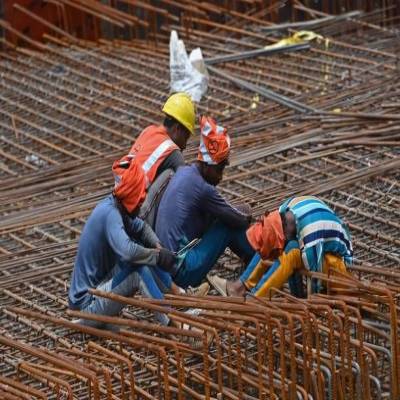- Home
- Infrastructure Transport
- ROADS & HIGHWAYS
- Construction challenges of Delhi Meerut Expressway Package 3
Construction challenges of Delhi Meerut Expressway Package 3
The APCO Chetak Expressway JV executed work on this package. Innovative planning, design and construction methods marked the construction of the viaduct of this project for reducing construction time by the selection of materials, technology and sequence of operations, shares Sanjay Shrivastava, Vice President. He shares more on the challenges in the construction of the package and how were these overcome...
a. Restricted ROW
The concession agreement was to construct six lane elevated highway (25.65 m width) in 32 m wide restricted ROW width (Pilakua Habitation), with both side dense shopping habitation, in a length of 4.680 Km. It is worth to mention that the road width provided in CA as per Schedule A is 45 m, except Pilakua Habitation where existing ROW was 32 m.
The road section is connecting Delhi to Lucknow, via Moradabad, Bareli, Shajahanpur and is very important road of the area.
The Pilakua area and road network was studied and found that there were neither proper service roads nor alternative routes where traffic can be diverted. Since there was no option, the 25.65 m wide deck construction has to be undertaken up with traffic plying in market place for a length of 4680 m, with a restricted width (ROW) of 32 m. Construction operations inevitably require work forces to occupy the roadway. There is a need to provide for sufficient space to perform construction operations, while reducing the impact of these operations on the travelling public. The construction scheme was very difficult with present day in situ working.
b. Safety of commuters
The safe and efficient flow of traffic approaching and passing through work zones was the major concern to highway users and those involved in construction of roadways. More frequently, the travelling public is demanding increased mobility, while displaying less tolerance for delays, increased travel time, and inconvenience because of congestion, especially congestion caused by highway facility construction operations.
Construction operations inevitably require work forces to occupy the roadway. There is a need to provide for sufficient space to perform construction operations, while reducing the impact of these operations on the road users and local residents.
The construction in Pilkhuwa habitation area with safety for the commuters plying underneath, the construction zone requires a broader and more comprehensive approach to the problem than looking for marginal improvements in existing techniques. Re-conceptualization of the problem during the planning phase, lead to alternative designs which were innovative and used improvised approach to construction that could yield greater benefits in terms of reduced delay, disruption, and safety.
The scheme was discussed at large for possible structural solutions, with all stakeholders and the most optimal working solution was thus obtained. The segmental construction was ruled out, for huge setup and transportation and erection of wide and heavy segments in restricted carriage way of busy market road.
c. Environment challenges
The present road in question is Dasna Hapur Road Project, section of NH 24, which handles more than 3000 traveler per hour (Maximum in peak time) in one direction, through Pilkhuwa habitation area.
The local public in Pilkhuwa Habitation was facing the severe environment concerns of Noise and Air by way of moving traffic and probable threat due to proposed viaduct construction towards air, noise, vibration, solid and liquid pollution.
The development of an ambitious program regarding the nuisance-mitigating infrastructure through a prototype system of integrated technologies is to contribute and reduce nuisance (noise, vibration and air, solid and liquid pollution). This includes a particularly original work regarding mitigation of air pollution in road.
- SERAPHINA D’SOUZA
Union Minister for Road Transport & Highways and MSMEs Nitin Gadkari recently inaugurated Package 3 of the Delhi-Meerut Expressway, built at a civil cost of Rs 10.57 billion. The project is expected to help decongest the NCR, reduce travel time and heavy traffic jams in this section, and bring a significant reduction in the pollution level owing to lower fuel consumption. The APCO Chetak Expressway JV executed work on this package. Innovative planning, design and construction methods marked the construction of the viaduct of this project for reducing construction time by the selection of materials, technology and sequence of operations, shares Sanjay Shrivastava, Vice President. He shares more on the challenges in the construction of the package and how were these overcome... a. Restricted ROW The concession agreement was to construct six lane elevated highway (25.65 m width) in 32 m wide restricted ROW width (Pilakua Habitation), with both side dense shopping habitation, in a length of 4.680 Km. It is worth to mention that the road width provided in CA as per Schedule A is 45 m, except Pilakua Habitation where existing ROW was 32 m. The road section is connecting Delhi to Lucknow, via Moradabad, Bareli, Shajahanpur and is very important road of the area. The Pilakua area and road network was studied and found that there were neither proper service roads nor alternative routes where traffic can be diverted. Since there was no option, the 25.65 m wide deck construction has to be undertaken up with traffic plying in market place for a length of 4680 m, with a restricted width (ROW) of 32 m. Construction operations inevitably require work forces to occupy the roadway. There is a need to provide for sufficient space to perform construction operations, while reducing the impact of these operations on the travelling public. The construction scheme was very difficult with present day in situ working. b. Safety of commuters The safe and efficient flow of traffic approaching and passing through work zones was the major concern to highway users and those involved in construction of roadways. More frequently, the travelling public is demanding increased mobility, while displaying less tolerance for delays, increased travel time, and inconvenience because of congestion, especially congestion caused by highway facility construction operations. Construction operations inevitably require work forces to occupy the roadway. There is a need to provide for sufficient space to perform construction operations, while reducing the impact of these operations on the road users and local residents. The construction in Pilkhuwa habitation area with safety for the commuters plying underneath, the construction zone requires a broader and more comprehensive approach to the problem than looking for marginal improvements in existing techniques. Re-conceptualization of the problem during the planning phase, lead to alternative designs which were innovative and used improvised approach to construction that could yield greater benefits in terms of reduced delay, disruption, and safety. The scheme was discussed at large for possible structural solutions, with all stakeholders and the most optimal working solution was thus obtained. The segmental construction was ruled out, for huge setup and transportation and erection of wide and heavy segments in restricted carriage way of busy market road. c. Environment challenges The present road in question is Dasna Hapur Road Project, section of NH 24, which handles more than 3000 traveler per hour (Maximum in peak time) in one direction, through Pilkhuwa habitation area. The local public in Pilkhuwa Habitation was facing the severe environment concerns of Noise and Air by way of moving traffic and probable threat due to proposed viaduct construction towards air, noise, vibration, solid and liquid pollution. The development of an ambitious program regarding the nuisance-mitigating infrastructure through a prototype system of integrated technologies is to contribute and reduce nuisance (noise, vibration and air, solid and liquid pollution). This includes a particularly original work regarding mitigation of air pollution in road. - SERAPHINA D’SOUZA






















